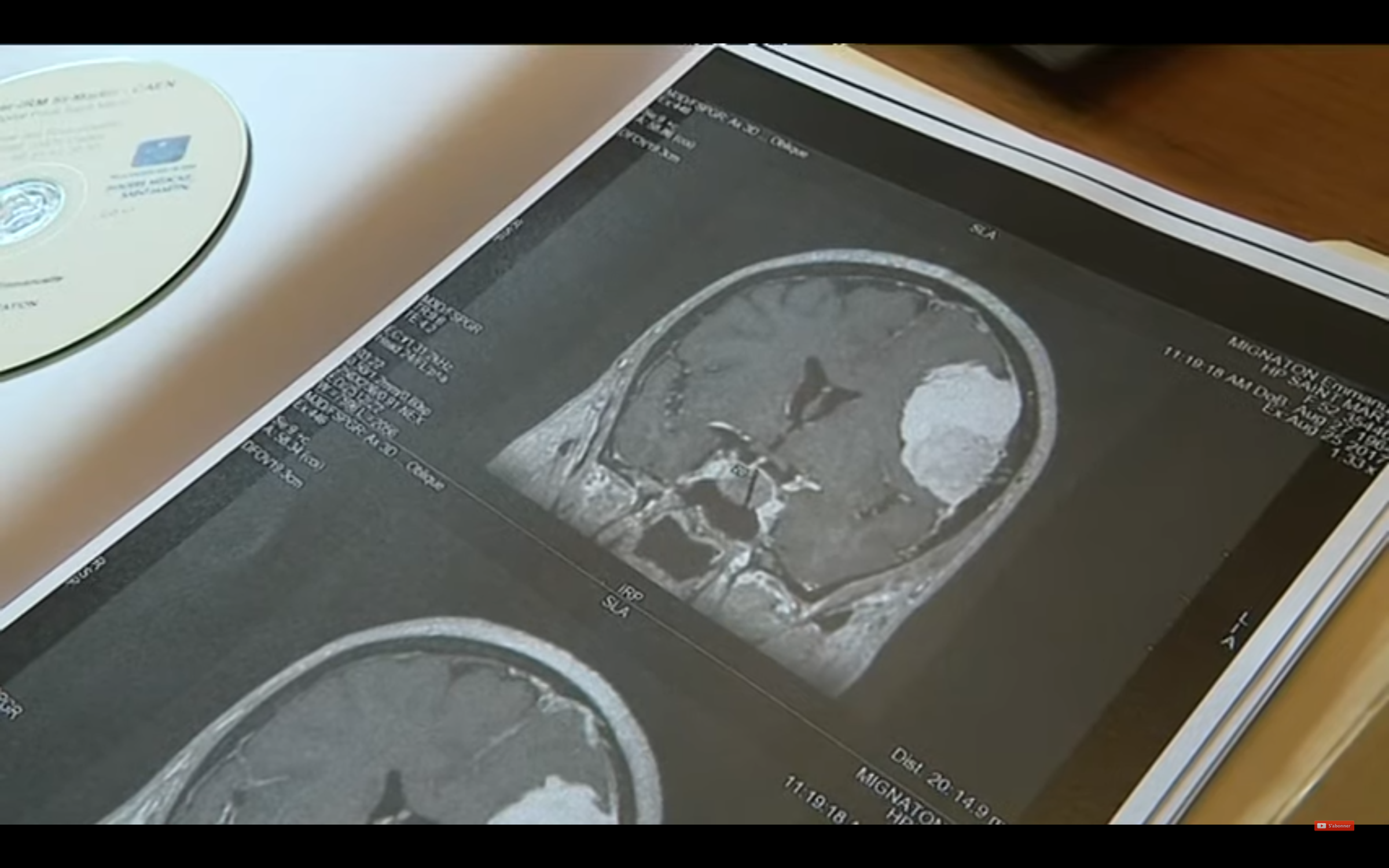Respective roles of PIK3CA mutations and the impregnation to cyproterone acetate in the tumorigenesis of mouse meningiomas
Pierre-Cyril Cômes, Tuan Le Van, Suzanne Tran, Solène Huard, Samiya Abi-Jaoude, Quitterie Venot, Pauline Marijon, Julien Boetto, Antoine Blouin, Franck Bielle, Yohan Ducos, Yu Teranishi, Michel Kalamarides, and Matthieu Peyre
Despite their rarity, PIK3CA mutations in meningiomas have aroused interest as potentially target ubiquitous changes due to their presence in benign and malignant sporadic tumors, but also in cases related to hormones.
Using new genetically modified models of mice, we show here that PIK3CA mutations in postnatal mening cells are sufficient to promote the formation of meningiomas but also the progression of the tumor in mice. Conversely, hormonal impregnation, alone or in combination with PIK3CA and NF2 mutations, does not induce the tumorigesis of meningiomas but promotes the formation of breast tumors. We then confirm in vitro the effect of PIK3CA mutations but not of the hormonal impregnation on the proliferation of primary cultures of mouse -mounted cells. Finally, we show by exomic analysis of the tumors of the breast and the meninges that the hormonal impregnation promotes the formation of breast tumors without additional somatic oncogenic mutation but that it is associated with an increased mutational load against the background of PIK3CA mutation. All of these results tend to suggest a preponderant role in PIK3CA mutations on hormonal impregnation in the tumorigesis of meningiomas, the exact effect of the latter remaining to be discovered.
Cancer gene therapy; https://doi.org/10.1038/S41417-023-00621-2
INTRODUCTION
Meningiomas are the most frequent primary tumors of the central nervous system in adults and are mostly mild (Grade I of the WHO). In recent years, considerable efforts have been made to elucidate the molecular biology of meningiomas at genetic, transcriptomic and epigenetic levels. If these studies have made it possible to better understand the tumorigesis of meningiomas, no additional treatment has yet emerged following these discoveries. Mutations of the NF2 gene remain the most common engine event in meningiomas, and the various biological roles of the Merlin, the product of the NF2 gene, make it difficult to develop effective treatment. We therefore decided to focus our efforts on a less frequent factor but easier to target in the tumorigesis of meningiomas, the Pik3CA gene, whose role in the disease has recently increased.
In WHO grade I meningiomas, PIK3CA mutations are present in 4.7 % of all tumors and in 7.4 % of non -NF2 meningiomas. In the majority of cases (68 %), PIK3CA mutations coincide with Traf7 mutations, which makes doubt that PIK3CA mutations alone are enough to promote the tumorigerisis of meningiomas. More recently, PIK3CA mutations in meningiomas have aroused interest due to their preponderant role in the tumorigenesis of meningiomas associated with hormones. Meningiomas are considered hormone-sensitive tumors because of their association with the female sex (sex-ratio, f/m 2: 1), the presence of progesterone receptors on their surface and the rapid evolution of the size of meningiomas observed during pregnancy. After several cases reports and series on the association between the taking of synthetic anti-Androgenic progestins (cyproterone acetate, chlormadinone acetate, nomigestrol acetate) and meningiomas, a recent epidemiological study confirmed the increase in the risk of developing meningiomas after prolonged anti-angogenic treatment. We have also characterized this association by demonstrating a change in the mutational landscape of meningiomas associated with progestins compared to a series of unrepected tumors. The meningiomas associated with the progestins were mainly tumors of the PIK3CA mutant skull base. The tumorigernesis mechanisms underlying the association between taking progestins and PIK3CA mutations are still unknown.
In order to determine whether PIK3CA mutations are enough to promote the tumorigesis of mild and aggressive meningomes and to determine the associated role of hormonal contribution, we have created a new MURIN MURIN MUNING MUTING PIK3CA. We show first of all that the expression profiles of progesterone receptors in mice are comparable to those of human meninges. We then demonstrate that, in mice, PIK3CA mutations in postnatal mening cells are sufficient to promote the formation of meningiomas, unlike the impregnation of cyproterone acetate, which is not sufficient to promote the formation of meningiomas in mice, whether it is alone or associated with PIK3CA and NF2 mutations. We confirm these results by an in vitro analysis of the effect of cyproterone acetate and PIK3CA mutations on primary cultures of dural and arachnoid cells of mice. Finally, we show that the progestogen impregnation promotes the formation of tumors without additional somatic mutation, but that it is associated with an increased mutational load when it is combined with PIK3CA mutations.
RESULTS
Expression of progesterone receptors in mouse meninges
In order to determine if the mouse is a reliable model to test the effect of hormonal impregnation compared to man, we have decided to study the expression of progesterone receptors in mouse meninges. The main progesterone receptor, PGR, is a cytoplasmic protein that diminishes and translocuous into the nucleus to activate the response elements (PRE) in DNA during the connection of progesterone. The nuclear coloring of the PGR is therefore considered a reliable marker of the activation of the PGR, and the PGR is expressed in the majority of meningiomas. In normal meninges, the expression of the PGR was observed in the normal arachnoid fabric of man and rabbit. In addition to PGR, other transmembrane receptors have been more recently associated with the effects depending on progesterone, such as PGRMC1 (Progesterone Receptor Membrane Component 1). Following his description in the brain's meninges, we decided to study his expression in mouse brain.
We first analyzed the expression of progesterone nuclear receptors in adult mice based on the hybridization data of Allen Atlas (fig. 1, upper panel, see link). Unlike PGDS, a robust marker of the meninges, PGR and PGRMC1 were not expressed in mouse meninges, except in dispersed places. As the images of the Allen atlas do not engage the leptumenincs, we have carried out an additional immunohistochemical analysis of the PGR and PGRMC1 progesterone receptors in mouse meninges. We show that PGRMC1 is expressed in the arachnoid cells from E18 both at the base of the skull and convexity. On the other hand, we were unable to highlight PGR nuclear coloring in the arachnoid and the development dura of development and adults (fig. 1, lower panel). Bulk RNA sequencing data from the neonatal duration confirm the expression of PGRMC1 and PGRMC2 in mouse meninges, but no PGR [19], as in the unicellular analyzes of the normal human dura [20]. Due to the similarity of the expression profiles of progesterone receptors in mice and humans, at least at the transcriptomic level, we considered that the mouse could be a reliable model of hormonal impregnation.
PIK3CA mutation in postnatal meningeled cells is sufficient to promote the formation of meningiomas in mice
To study the role of the mutation of Pik3ca in the meningeal tumorigerisse, we had previously generated a cohort of PGDSCRE mouse; PIK3CA and observed that the prenatal activation of PIK3CA in PGDS-POSIDIF cells was not sufficient to promote the tumorigenesis of meningiomas in mice. We therefore sought to analyze the effect of postnatal activation of Pik3ca and generated a first cohort of 20 mice Pik3ca Flox/Flox to which we injected the Adcre (average volume: 3 μl) between day 2 and day 5 postnatal (Table 1 and Figure 2, see link). Due to the intravascular and subcutaneous diffusion of the Adcre, we observed 95 % of early hypertrophy of the head associated with subcutaneous vascular malformations, leading to early mortality (average survival: 1.6 months) (fig. Additional). During histological analysis, we nevertheless observed 30% of meningiomas, including one mouse with two distinct meningiomas of different histological subtypes (fig. 3a) and a grade II tumor with cerebral invasion and several mitoses in a 9-month-old mouse (fig. 3c, d). It is interesting to note that we have also observed a case of intraparenchymal cavernome (fig. 3b).
We have also decided to analyze the effect of activation of Pik3ca in adult mouse meninges. A cohort of 22 PIK3CA Flox/Flox was therefore injected with Adcre (average volume: 6 μl) at 6 weeks, either in terms of convexity (15 mice), or at the level of the skull (7 mice). We have observed 50 % of meningiomas, including a mouse hosting fibroblastic meningiom of convexity and transitional meningioma from the base of the skull (fig. 3rd, F). While meningiomas were mainly meningothelial in the postnatal model (5/6, 83%), they were mainly fibroblastic in the adult model (7/11, 63%).
Overall, these results demonstrate that the postnatal expression of a mutant form of Pik3ca in the meninges is sufficient to promote the formation of meningiomas of different histological grades and subtypes, unlike the prenatal expression.
Cyproterone acetate does not promote the formation of meningiomas in mice, whether alone or in combination with mutations of Pik3CA or NF2.
In order to study the role of the taking of progestins on the tumorigesis of meningiomas, we treated a cohort of 29 wild mouse with cyproterone acetate (ACP) for 9 months. After an average monitoring of 11 months, we found no meningioma with histological analysis but observed an hypertrophy of the uterus (fig. 4a) in all mice, thus demonstrating the impregnation by the ACP, as described previously in the murine models of breast cancer. Interestingly, we also discovered breast tumors in 90% of mice, defined as Muco-Epidermoid carcinomas (Fig. 4b, C) and a spinal intramedullary epidermoid cyst (Fig. 4D). In order to determine if the taking of progestins and the activation of PIK3CA could synergize to promote the formation of meningiomas in mice, we treated a cohort of 22 PGDSCRE mice; PIK3CAH1047R with ACP for 8 months. As with the first group steeped in ACP, the mice were sacrificed after an average follow -up of 8.3 months due to breast tumors. The histological diagnosis has not revealed any meningioma. The frequency of meningiomas being low in PGDSCRE mice; PIK3CA H1047R , we sought to determine whether the ACP taking could enter into synergy with the postnatal activation of PIK3CA mutations. In order to avoid the effects of the intravascular and subcutaneous diffusion of the ADCRE, we have lowered the volume injected with 1 μl and generated two cohorts of Adcre mouse; PIK3CA H1047R with (13 mice) and without (14 mice) impregnation of the ACP. The rate of subcutaneous vascular malformations was lowered to 62% in the control group and to 23% in the group treated by ACP. The survival of the mice has nevertheless been reduced (fig. 2b), and 10 out of 13 mice received only 3 months of impregnation at the ACP, against 9 months in the previous cohorts. While the frequency of meningiomas in the control group was similar to that of our previous cohort (29 %against 30 %), it was much lower (8 %) in the group treated with ACP.
Finally, we applied that the taking of progestins could contribute to the growth of pre -existing benign tumors. So we decided to treat a cohort of 17 PGDSCRE HET ; NF2Del2/Flox with cyproterone acetate compared to a witness cohort of 19 mice PGDSCRE HET ; NF2 Del2/Flox . Histological analysis after an average follow -up of 9.5 months revealed 88 % fibroblastic meningiomas of the skull base in the group treated by ACP and 89 % fibroblastic meningiomas from the base of the skull in the control group. The average size of the tumor was 0.2294 mm2 (median: 0.118 mm2; interval: 0.033-0.718) in the group treated by ACP and 0.305 in the control group (median: 0.256 mm2; interval: 0.067-0.823). We did not find a statistically significant difference in the size of the tumors between the two groups. Collectively, these results indicate that cyproterone acetate has not favored the training and/or progression of meningiomas in mice, whether on a genetic background linked to PIK3CA or NF2.
PIK3CA mutations, but not cyproterone acetate increases the proliferation of in vitro cells in vitro
To analyze the effect of activation of Pik3ca in the meninges as a function of their nature, we have established primary cultures of arachnoid and duration from the meninges of the base of the PIK3CA H1047R . Adcre infection of primary cells in vitro has been evaluated by the detection of the fluorescence of the GFP (Fig. 5C). No fluorescence has been expressed in the control cells infected with Adlacz (data not presented). The proliferation tests have shown that the expression of Pik3CA H1047R induced a proliferative advantage both in the arachnoid and dural cells on day 9 (p <0.05, test t) (fig. 5a, b). Increased proliferation has been associated with activation of the Pi3K-AKT-MTOR track by increased phosphorylation of AKT and S6RP (Fig. 5D) demonstrated both in the arachnoid and the duration (additional table 1). Cyproterone acetate has not increased cell proliferation of dural cells, whether alone or in combination with the expression of Pik3CA H1047R (Fig. 5th, G). In arachnoid cells, however, cyproterone acetate has increased cell proliferation, alone and in combination with ACP, without reaching a statistical meaning (fig. 5F, H).
Analysis of the exome of tumors and meninges linked to hormone and pik3ca in mice
In order to determine whether the impregnation of progestins is enough to promote mutagenesis in mouse tissues, we have decided to carry out an analysis of the exoment on mouse brain treated with ACP compared to control of control and in breast tumors linked to the ACP, either on a wild -type background, or on a background of mutant PIK3CA. Five tumors and two meninges were analyzed. We did not find an oncogenic mutation in the mouse brain. In the breast tumor developed on a wild -type background, no oncogenic mutation has been observed. It is interesting to note that in the breast tumors developed in combination with PIK3CA mutations, we have found additional mutations already described in human breast tumors, including mutations of MAP2K4 and CTNNB1 described in the Cosmic database (Fig. 6 and additional table 2, see link).





